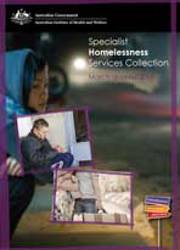Summary
This report presents results of the Specialist Homelessness Services Collection (SHSC) for the March quarter 2012. The SHSC describes the clients who receive assistance from specialist homelessness agencies and the services they receive.
Clients
In this quarter, an estimated 102,356 clients were assisted by specialist homelessness agencies―59% were female and 41% male.
Aboriginal and Torres Strait Islander people represented 21% of clients.
Domestic and family violence was the most common main reason for seeking assistance (24%).
In 19% of support periods, clients had 'slept rough' in the month before presenting for support.
Most clients presented to specialist homelessness agencies alone (69%). For those presenting in families or groups, 'single people with children' was the most common type of family to present for assistance (76% of support periods for family members). This was followed by couples with children (15% of support periods).
The age distribution of clients is similar across Major cities, Inner regional, Outer regional, Remote and Very remote areas, but there were pronounced sex differences. Females represented a higher proportion of clients with increasing remoteness (57% of clients were female in Major cities, compared with 82% in Very remote areas).
Accommodation and other support services
Accommodation was provided to clients in 34% of support periods. Short-term or emergency accommodation was provided most often (in 63% of support periods where accommodation was provided). Where a need for short-term or emergency accommodation was identified, it was met directly by the agency in 65% of support periods.
An estimated total of 1,691,587 accommodation nights were provided in the reporting period to clients of specialist homelessness agencies. On average, 18,594 clients were accommodated on any given night. The average length of accommodation decreases with increasing remoteness of the specialist homelessness agency.
Clients most needed advice or information (in 70% of support periods). In 97% of support periods where information was needed, it was provided directly by agencies.
Outcomes
There were slightly fewer clients living without shelter, or in inadequate dwellings, at the end of support (4% of closed support periods, compared with 7% at the beginning of these support periods).
There was a small decrease in the proportion of clients with no housing tenure at the end of support (25% of closed support periods, compared with 29% at the beginning of these support periods).
There was a slight decrease in clients who had no income after support (7% of closed support periods, compared with 8% at the beginning of these support periods).



